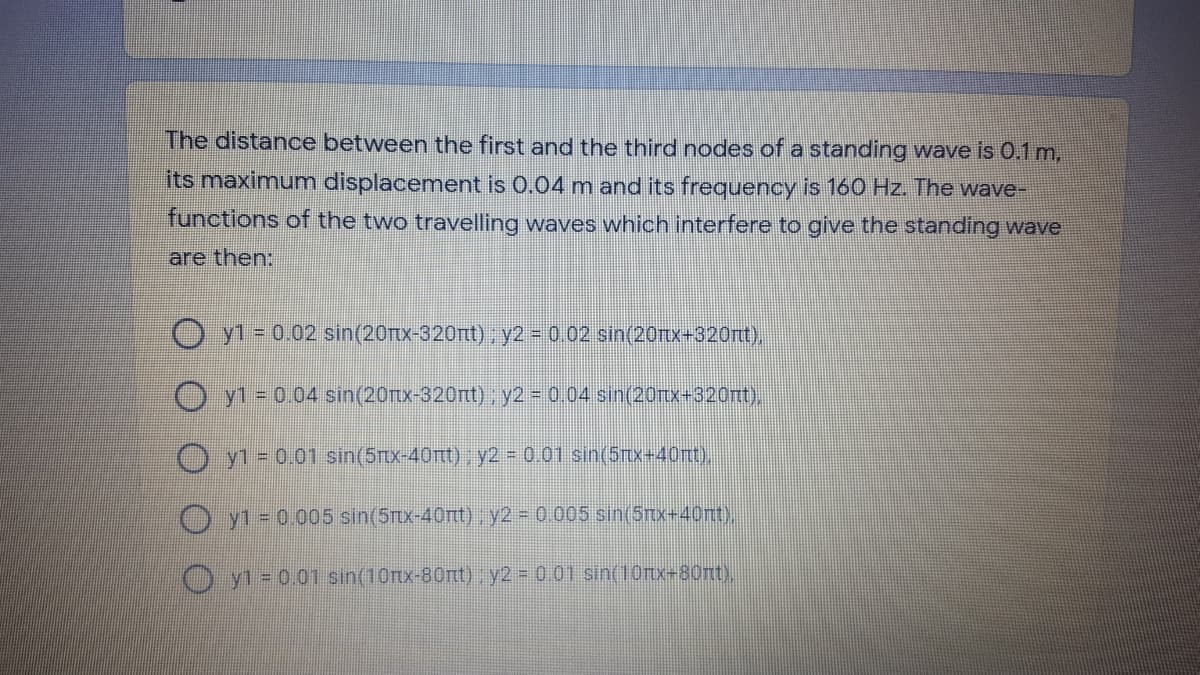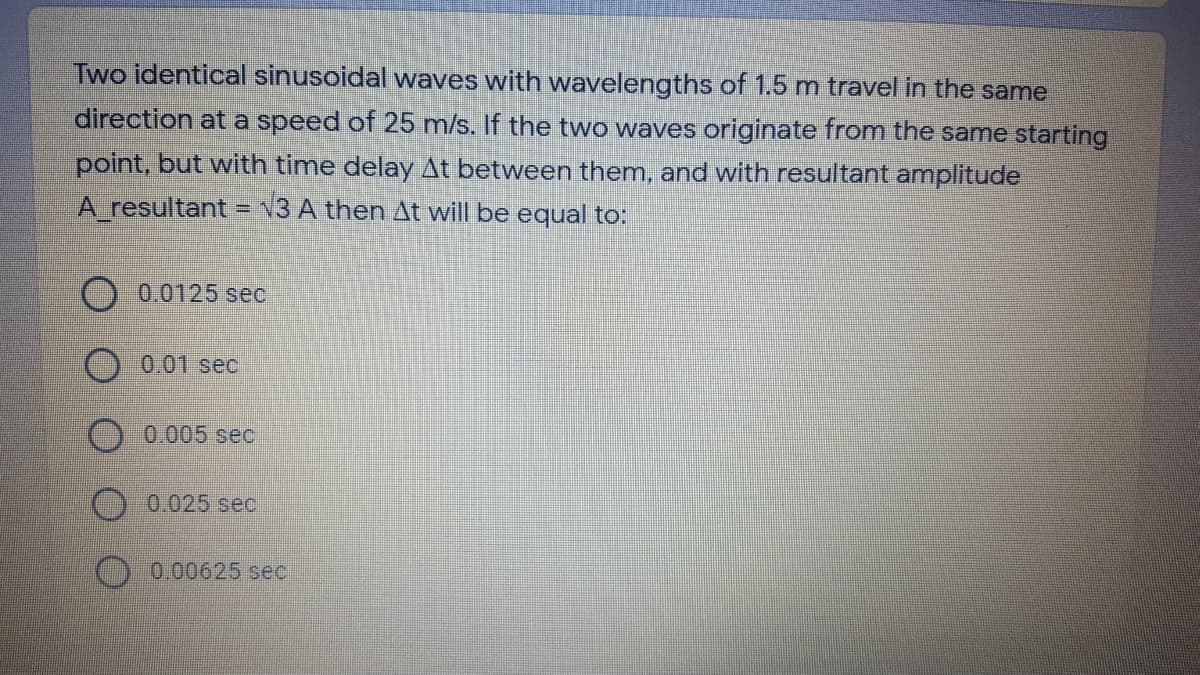The distance between the first and the third nodes of a standing wave is 0.1 m, its maximum displacement is 0.04 m and its frequency is 160 Hz. The wave- functions of the two travelling waves which interfere to give the standing wave are then: O y1 = 0.02 sin(20rx-320rt), y2 = 0.02 sin(20TX+320rt), O y1 = 0.04 sin(20rtx-320rt) ; y2 = 0.04 sin(20Ttx+320rt), O y1 = 0.01 sin(5rtx-40Ttt), y2 0.01 sin(5Ttx+40nt), O y1 = 0.005 sin(5rtx-40nt) .y2 0.005 sin(5rtx+40nt), O y1 = 0.01 sin(10tx-80mt), y2 = 0.01 sin(10rtx-80nt),
The distance between the first and the third nodes of a standing wave is 0.1 m, its maximum displacement is 0.04 m and its frequency is 160 Hz. The wave- functions of the two travelling waves which interfere to give the standing wave are then: O y1 = 0.02 sin(20rx-320rt), y2 = 0.02 sin(20TX+320rt), O y1 = 0.04 sin(20rtx-320rt) ; y2 = 0.04 sin(20Ttx+320rt), O y1 = 0.01 sin(5rtx-40Ttt), y2 0.01 sin(5Ttx+40nt), O y1 = 0.005 sin(5rtx-40nt) .y2 0.005 sin(5rtx+40nt), O y1 = 0.01 sin(10tx-80mt), y2 = 0.01 sin(10rtx-80nt),
Principles of Physics: A Calculus-Based Text
5th Edition
ISBN:9781133104261
Author:Raymond A. Serway, John W. Jewett
Publisher:Raymond A. Serway, John W. Jewett
Chapter14: Superposition And Standing Waves
Section: Chapter Questions
Problem 4P
Related questions
Question

Transcribed Image Text:The distance between the first and the third nodes of a standing wave is 0.1 m,
its maximumn displacement is 0.04 m and its frequency is 160 Hz. The wave-
functions of the two travelling waves which interfere to give the standing wave
are then:
O yl = 0.02 sin(20x-320rtt), y2 = 0.02 sin(20rtx+320rt),
O y1 = 0.04 sin(20rx-320rt), y2 = 0.04 sin(20rIX=320nt),
O yl = 0.01 sin(5Tx-40rtt) y2 0.01 sin(5nx+40mt),
O y1 = 0.005 sin(5Ttx-40rtt) , y2 0.005 sin(5rx+40nt),
Oyl= 0.01 sin(10nx-80rtt), y2 0.01 sin(10rtx-80nt),

Transcribed Image Text:Two identical sinusoidal waves with wavelengths of 1.5 m travel in the same
direction at a speed of 25 m/s. If the two waves originate from the same starting
point, but with time delay At between them, and with resultant amplitude
A_resultant = N3 A then At will be equal to:
0.0125 sec
0.01 sec
0.005 sec
O 0.025 sec
O 0.00625 sec
O O O O
Expert Solution
This question has been solved!
Explore an expertly crafted, step-by-step solution for a thorough understanding of key concepts.
Step by step
Solved in 3 steps with 3 images

Knowledge Booster
Learn more about
Need a deep-dive on the concept behind this application? Look no further. Learn more about this topic, physics and related others by exploring similar questions and additional content below.Recommended textbooks for you

Principles of Physics: A Calculus-Based Text
Physics
ISBN:
9781133104261
Author:
Raymond A. Serway, John W. Jewett
Publisher:
Cengage Learning

University Physics Volume 1
Physics
ISBN:
9781938168277
Author:
William Moebs, Samuel J. Ling, Jeff Sanny
Publisher:
OpenStax - Rice University

Physics for Scientists and Engineers, Technology …
Physics
ISBN:
9781305116399
Author:
Raymond A. Serway, John W. Jewett
Publisher:
Cengage Learning

Principles of Physics: A Calculus-Based Text
Physics
ISBN:
9781133104261
Author:
Raymond A. Serway, John W. Jewett
Publisher:
Cengage Learning

University Physics Volume 1
Physics
ISBN:
9781938168277
Author:
William Moebs, Samuel J. Ling, Jeff Sanny
Publisher:
OpenStax - Rice University

Physics for Scientists and Engineers, Technology …
Physics
ISBN:
9781305116399
Author:
Raymond A. Serway, John W. Jewett
Publisher:
Cengage Learning

Physics for Scientists and Engineers: Foundations…
Physics
ISBN:
9781133939146
Author:
Katz, Debora M.
Publisher:
Cengage Learning

An Introduction to Physical Science
Physics
ISBN:
9781305079137
Author:
James Shipman, Jerry D. Wilson, Charles A. Higgins, Omar Torres
Publisher:
Cengage Learning